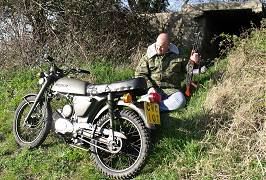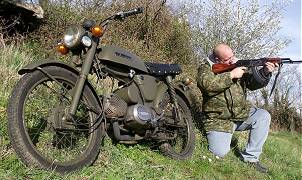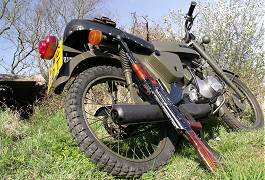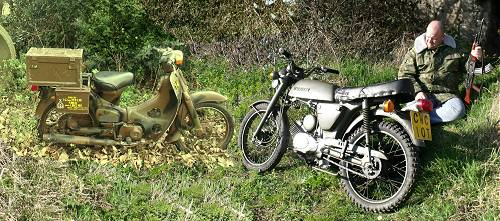Might military mopeds seem a little unlikely for the modern British army? Perhaps you don’t notice them very often, but then, maybe you’re not supposed to—because they’d be camouflaged! No, these machines may not be quite the real McCoy, but they’re certainly out there on the roads, fighting the battle for urban survival as daily commuter transport.
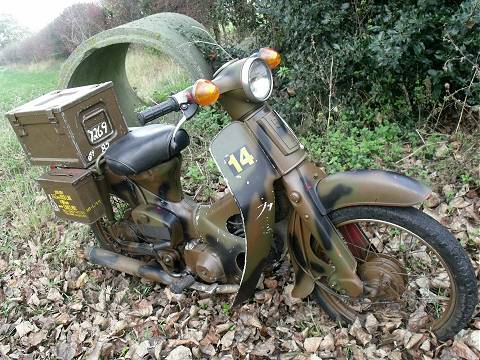
One might call this a little spin-off from the ex-military vehicle enthusiast movement, where you see occasional ex-army motor cycles or trucks in civilian use, and there’s a lot to be said for liberally sloshing a coat of budget olive drab over everything, rather than the trouble and cost of fancy paint and shiny chrome restoration. It’s certainly cheap, gives the bike an identity, and seems a reasonable option for any aging and tatty rat bike.
During WWII there were well known examples of small capacity bikes being employed by the military, probably most famously the paratrooper’s Excelsior Welbike with 98cc Villiers Junior de Luxe autocycle engine, Royal Enfield 125cc ‘Flying Flea’, and James 125cc ML (Military Lightweight), so maybe in later years it might not be so unlikely to find … a Honda C50?
Dating from 1986, the most characteristic aspect of this C50 is that it’s finished in camouflage paint, and seemingly made up as a munitions transport. There’s a single pad seat, which hinges up the same as the old dual seats, to access the petrol filler beneath. A rear carrier straddles the frame behind the seat, carrying a large 18"×11"×10" ammunition box as a rear carrier, marked ‘700 rounds 7.62mm Ball L2A2’, and two smaller 10"×7"×4" ammo boxes on each side marked ‘200 cartridges 7.62mm M13 for MG M60-M73’ and ‘200 rounds 7.62mm MXD-LNK’.
It’s a while since we’ve ridden any Honda ‘crunchy’ models, and that was always much older 1960s and ’70s machines. This one is well into the 1980s, and some things have changed … like where’s the ignition switch? It’s no longer on the side panel, not on the steering head, right-hand leg shield? Nope! Ah, there, tucked into the left-hand leg shield now.
The fuel tap is still on the carburettor, hiding in its little cave in the right-hand leg shield … but which way does that switch go for on? Trying to read the tiny lettering one the side of the tap, through the dirt, in the gloom … have to put the glasses on … no, maybe a torch … no … give up. In the end we just turn it so the lever points down, and if it happens to stop, then we’ll just switch it to another direction.
Choke? Well, we recall there used to be a little lever on the carburetter, but that’s not there anymore … now it’s a pull knob on the steering head.
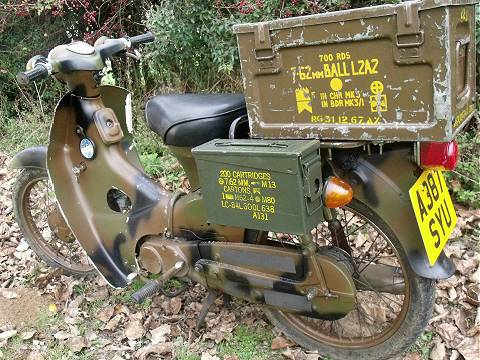
After a few fruitless kicks, we try it without choke and the engine fires right up.
At least the heel and toe rocking-lever gear change is still the same, so back for first … nothing … back for first … no, there’s definitely no gear there, so we sit in the kerb, clicking through the gear change and opening the throttle to see what’s what. OK, so Honda has changed the gearbox to a three-straight-down selection with neutral at the top now.
Finally we get under way. Pulling from the kerb is the same old lurching take-off that the semi-automatic crunchies used to do, that bouncy leading-link front suspension certainly hasn’t changed. Up the road, click up the gears to top, and ease ourselves onto the main road.
We’re not expecting much from this C50 since it wears a 30mph restricted plate, and the owner reports that it doesn’t perform to his expectations in comparison to the older pre-restricted models. It has, however, received some minor upgrades; one more tooth on the front sprocket, and a changed exhaust. Apparently the original (rotted) exhaust system was model marked ‘30mph’, but this pattern replacement didn’t seem to mention any similar restriction.
Now, when Honda say something is limited to 30, then that’s exactly what you’d expect it to do, right on the button—but there’s the exhaust change and raised ratio to take into account. The owner has also told us he knows the speedometer reads slightly slow. Best on the flat in an upright position indicated 34mph, and no amount of encouragement could get the needle to make the 35 line, our pace rider however clocked this at 36. On flat in a crouch indicated 36mph, while the pacer clocked 38. At screaming revs in typical Honda style (do they never top out?), the downhill run ran the needle off the end marker of the 40mph clock … was that 41–42ish? Our pacer confirmed his speedometer just tipped 44mph, and we went on to charge the following hill climb at no less than 34 by the time it crested the rise.
In conclusion, we thought the little Honda gave a good account of itself, and can’t imagine why the bike’s 21-stone owner might not be so satisfied with the little C50’s performance? There weren’t any flat spots under acceleration so carburetion seemed good, though there was a bit of a dead zone at low revs in top gear, probably not unexpectedly for a 50cc four-stroke with raised gearing, but once it pulled past 25, then was generally OK.
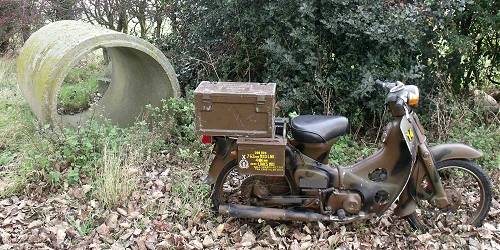
Maybe our memory of old C50s and C70s was a little smoother than this newer restricted model reality, but there was a low level vibration tingle through the footrests, and this motor did feel a little harsh at speed—rather like a furious sewing machine.
Swapping with our pace rider on the way back, riding beside the C50 sounded more pleasant than actually being on it. The phuttering exhaust note could be more easily discerned from the rear quarter, and the motor sounded quite relaxed around 25–30. Generally the bike rode well and stopped well, apart from the usual rearing-up effects from the notorious leading-link front suspension, but that’s generally accepted as part of the classic heritage and character of these machines.
Overall, this ‘restricted’ C50 performed considerably better than expected for a limited 50, and just goes to show the old Honda ‘crunch’ is just as bullet-proof as ever!
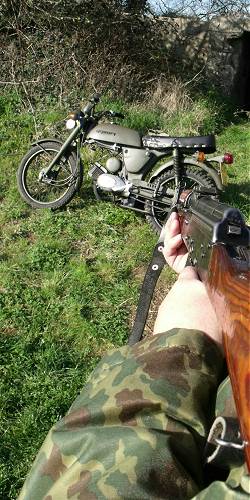
Our second ‘moped army’ bike is a Suzuki A100 ‘Scrapheap Special’ basically built out of odd salvage parts. The story goes that it came from the local tip around 1992 and was reconstructed on pretty much a zero budget from any scavenged bits that could be cobbled to fit. Since the motor was rather loose and rattley, and the clutch seemingly at end adjustment, there wasn’t much expectation that it would last very long, but mercilessly thrashed, abused, left out in all weathers, and 10 years later it’s still rattling along much the same! Just goes to show what a tough little bike it must be!
What original paintwork remained wasn’t worth any concern, and a slosh of olive drab soon achieved an even colour.
Apart from the pozi-force oiling system, the A100 is a pretty basic type old-time commuter motor cycle with very little in the way of gizmos, gadgets, or fancy bells and whistles. There’s a simple four-speed gearbox, one-down/three-up with a difficult-to-find neutral unless the engine is stopped. There’s a green neutral light to tell when you’ve got it, but that’s no easy task while the engine is running. It just keeps teasingly blinking at you as you click through and back again.
The console box on the headset houses a key-switch, an 80mph speedometer but no rev counter, and a couple of indicator lights. The various indicators are all similarly shaped, but their odd lenses suggest varying origins. Who cares? They’re orange and they flash!
A basic lever fuel tap turns on at centre left of the tank, off–on–reserve, then choke operates under the left handle cluster and generally only requires a tweak for cold starting in the morning, after which you can flick the lever off within some 15 seconds.
A couple of kicks rouse the motor easily enough, which sounds like a tired old campaigner, while the exhaust tone is quietly subdued by the welded-on silencer from a later model GP100. Clutch is light, gear selection easy-click, and we’re told the bike is well used to military-style treatment so there’s no need to nurse it!
Anyone used to riding plodding old Villiers autocycles and the like is probably not going to readily adjust to the sort of revs these later Japanese two-strokes can run. Old timers tend to open them up, hold the gears till they think it’s revving quite enough, then change up. Wrong apparently!
You rev it till you think you should change up, then hold it wide open in gear and wait for the power band to kick in!
The real motor performance is all at the top end of the revs, and anything less is apparently just ‘labouring the motor’! Sounds like Ernest Thrasher’s riding guide to us, but we give it a try.
The engine feels loose & worn, and sounds rather rattley, but goes on to run smoothly when it gets up to revs—how many revs? It just feels endless compared to the autocycles of this capacity we usually run, but can’t really put any figure on it without a rev counter.
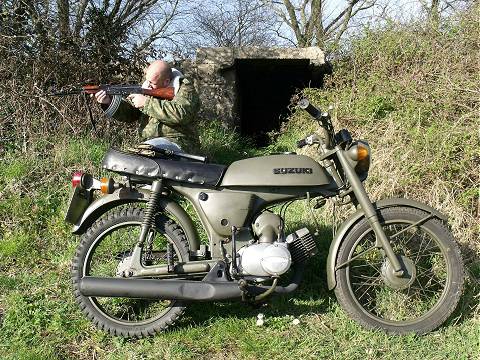
‘Where might the urban army redline be’, we enquire?
‘Beyond anything you might ever rev it to’ seems to be the reply. Wish we’d never asked!
There’s not much in terms of torque at low speed, but the engine starts to pick up about mid-range, then hold onto the gear and the front goes light as the revs just go on and on. We feel as if the natural change-up point is about 40 in third, but are told you can run it on to 52! Top gear seems to be comfortably cruising up to 50mph, but at this pace you’re still outside the top-end power band, and have to work the motor above this to get into take-off speed.
The power band can fairly readily take the bike up to just over 60 if you dip down to reduce drag. Anything beyond this is going to pretty much come down to catching the most favourable conditions (strong tailwind or downhill), which can reportedly take it across the 65 marker. The way the bike performs, it seems likely that the front sprocket has been changed to raise the drive ratio.
The rear shocks (probably not the correct ones, and likely scavenged off something else) feel over-sprung and practically undamped, while the knobbly rear tyre helped neither general handling nor cornering at speed. There weren’t really many positive comments to make about the general handling, and we managed to find a particularly interesting weave when pulling out of a lorry slipstream at 50mph on the dual-carriageway…
The front brake was generally ineffectual, feeling heavy on the lever, but failing to deliver much in the way of any real stopping ability. The rear footbrake was OK, but hauling the bike down from speed on the knobbly rear tyre & suspension combination could make the descent a little ‘lively’.
The engine performs somewhat better than the handling and brakes, and can certainly get you into more trouble than you want if you try pushing it hard through green lane sections.
The Suzuki A100 probably represents much the same basic commuter two-stroke single brought on 40 years into the 1970s. It’s another on-going step of the developing 100cc motor cycle, a story that continues from the pre-war French BMA vélomoteurs, early English Cyc-Auto and Villiers Junior autocycles, through to the post-war 2F powered single-speed autocycles, and 1F, 4F & 6F two-speed motor cycles.
The ‘big four’ Japanese manufacturers have all subsequently continued this 100cc capacity with quite a range of popular models in the size that should be familiar to many: Honda CB100 (four-stroke) and H100 (two-stroke); Kawasaki GA5, G7T and KH100; Suzuki A100 series A from 1969 to 1980, GP100, TS100; Yamaha HL1, YB100, RS100, DT100, RXS100, etc.
Suzuki’s A100 first washed up on UK shores way back in June 1969, evolving through several guises till finally being discontinued in April 1980.
